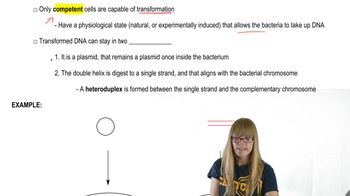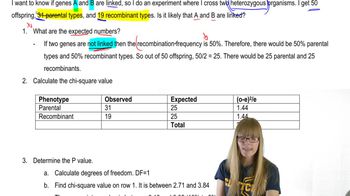Here are the essential concepts you must grasp in order to answer the question correctly.
Transformation in Bacteria
Transformation is a process where bacteria take up foreign DNA from their environment, leading to genetic changes. In this experiment, the donor strain (a⁺b⁺c⁺) provides functional alleles to the recipient strain (a⁻b⁻c⁻), allowing researchers to study gene linkage and recombination based on the resulting phenotypes of the transformants.
Recommended video:
Linkage and Recombination
Linkage refers to the tendency of genes located close to each other on a chromosome to be inherited together. Recombination occurs during meiosis, where segments of DNA are exchanged between homologous chromosomes. The frequency of different phenotypic classes in the transformants can indicate the relative distances between genes, with closer genes showing lower recombination frequencies.
Recommended video:
Phenotypic Classes and Frequencies
The phenotypic classes represent the observable traits of the transformants based on the combinations of alleles received from the donor DNA. By analyzing the frequencies of these classes, one can infer the genetic linkage and the order of the genes. Higher frequencies of certain classes suggest that those genes are linked, while lower frequencies indicate greater distances or independent assortment.
Recommended video:




